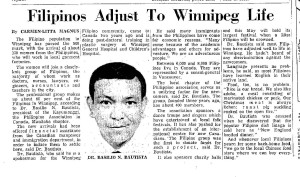From 500 to over 30,000: Migrating to and Staying in Winnipeg
I am sure there are many well-known assumptions Winnipegers might have about Filipino migration to Winnipeg. There are, of course, the obvious ones like Filipinos migrate to Canada to leave a ‘Third-World’ country, seek a ‘better life’ and secure the future of their children. As true as these assumptions may be about many Filipino-Canadians today, one would have to wonder if such reasoning was always the case. After all, the community was first established by a number of young, often single, well-to-do group of educated, worldly professionals.
Take the attached 1968 Winnipeg Fr ee Press article for example. In Carmen-Litta Magnus’ article “Filipinos Adjust to Winnipeg Life” (Winnipeg Free Press, 7 December 1968). She describes a growing community of 500 Filipinos represented largely (she claims 90 percent) by professionals. At the time, 170 Filipina women had just arrived in the city as Canada Manpower recruits to work in the then bustling garment industry. The photo of the man happens to be of Dr. Basilio N. Bautista, then president of the Kayumanggi Philippine Association, and a post-doctoral student training in plastic surgery at Winnipeg General Hospital and Children’s Hospital. He explains that the community has grown because “[m]any come because of the academic advantages and others for adventure. We are an adventurous people.” An interesting viewpoint that is quite the opposite of what most assume today.
ee Press article for example. In Carmen-Litta Magnus’ article “Filipinos Adjust to Winnipeg Life” (Winnipeg Free Press, 7 December 1968). She describes a growing community of 500 Filipinos represented largely (she claims 90 percent) by professionals. At the time, 170 Filipina women had just arrived in the city as Canada Manpower recruits to work in the then bustling garment industry. The photo of the man happens to be of Dr. Basilio N. Bautista, then president of the Kayumanggi Philippine Association, and a post-doctoral student training in plastic surgery at Winnipeg General Hospital and Children’s Hospital. He explains that the community has grown because “[m]any come because of the academic advantages and others for adventure. We are an adventurous people.” An interesting viewpoint that is quite the opposite of what most assume today.
Now with over 30,000 strong and growing, the Filipino-Canadian community in Winnipeg can credit the Manitoba Provincial Nominee Program, Federal Family Reunification Program, Temporary Foreign Worker Program, births and an institutionalized labour export system in the Philippines to its growth. But, when you dig deep and see that the community has grown because people also stayed, settled and planted roots in the city (despite the harsh winters and everything else that bemoans Winnipeg), one may realize that there is an element of individual agency working as well. The community’s foundation in Winnipeg stands on the decisions of an adventurous number of Filipino voyageurs. Economic divide or not, the deeper reasons why the first few Filipinos chose to call Winnipeg home deserve to be explored.


